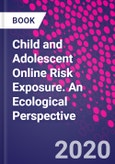Child and Adolescent Online Risk Exposure: An Ecological Perspective focuses on online risks and outcomes for children and adolescents using an ecological perspective (i.e., the intersection of individuals in relevant contexts) for a better understanding of risks associated with the youth online experience. The book examines the specific consequences of online risks for youth and demonstrates how to develop effective and sensitive interventions and policies. Sections discuss why online risks are important, individual and contextual factors, different types of risk, online risks among special populations, such as LGBT youth, physically or intellectually disabled youth, and ethnic and religious minorities, and intervention efforts.
Please Note: This is an On Demand product, delivery may take up to 11 working days after payment has been received.
Table of Contents
Preface
Section I: Introduction
1. Introduction Lawrence B. Schiamberg and Michelle F. Wright
Section II: Types of Online Risks
2. Problematic internet use: causes, consequences, and future directions Michelle F. Wright, Tali Heiman and Dorit Olenik-Shemesh
3. The process of exploitation and victimization of adolescents in digital environments: the contribution of authenticity and self-exploration John D. Ranney
4. Online contact risk behaviors and risk factors among Japanese high school students Ikuko Aoyama
5. Understanding child and adolescent cyberbullying Oonagh L. Steer, Peter J.R. Macaulay and Lucy R. Betts
6. Online aggression and romantic relationships in adolescence Chelsea Olson and Amy Bellmore
7. The longitudinal associations of cyberbullying and cybervictimization: preliminary findings from a two-wave study Fatih Bayraktar and Michelle F. Wright
8. The rising threat of cyberhate for young people around the globe Sheri Bauman, Vanessa M. Perry and Sebastian Wachs
9. Same incident, different story? Investigating early adolescents' negative online peer interactions from different perspectives Sara Pabian, Sara Erreygers, Kathleen Van Royen and Heidi Vandebosch
Section III: Special Populations and Online Risks
10. Parental vigilance, low self-control, and Internet dependency among rural adolescents Magda Javakhishvili and Alexander T. Vazsonyi
11. Cyberbullying perpetration and victimization among ethnic minority youth in the United States: similarities or differences across groups? Guadalupe Espinoza and Fardusa Rashid Ismail
12. Racial and ethnic diversity in the social ecology of online harassment and cybervictimization: the adolescent school context Gia Elise Barboza and Lawrence B. Schiamberg
13. Cyberbullying and cybervictimization among youth with disabilities Morgan A. Eldridge, Michelle L. Kilpatrick Demaray, Jonathan D. Emmons and Logan N. Riffle
14. The negative online experiences of maltreated children and adolescents Michelle F. Wright
15. LGBTQ youth and digital media: online risks Tyler Hatchel, Cagil Torgal, America J. El Sheikh, Luz E. Robinson, Alberto Valido and Dorothy L. Espelage
16. Gendered nature of digital abuse in romantic relationships in adolescence Beatriz V�llora, Santiago Yubero, Elisa Larra�aga and Ra�l Navarro
Section IV: Interventions and Policies
17. Advances in the cyberbullying literature: theory-based interventions Christopher P. Barlett, Matthew M. Simmers and Luke W. Seyfert
18. Online risk interventions: implications of theory of mind and other considerations Tina Montreuil and Hagit Malikin
19. Using focus groups and quality circles to enable pupil voice in European teenagers from socioeconomically disadvantaged backgrounds Noel Purdy, Jayne Hamilton, Peter K. Smith, Catherine Culbert, Herbert Scheithauer, Nora Fiedler, Antonella Brighi, Consuelo Mameli, Annalisa Guarini, Damiano Menin, Trijntje V�llink and Roy A. Willems
20. Conclusion Michelle F. Wright and Lawrence B. Schiamberg
Authors
Michelle F. Wright Research Associate, Pennsylvania State UniversityPostdoctoral Research Fellow, Masaryk University. Dr. Wright is a national and international expert on online risks among children, adolescents, and adults, and she has written extensively on the nature of online risks, the measurement of online risks, and the contextual factors that impact the likelihood of experiencing online risks. She has edited three books related to online risks and served as editor of five special issues on online risks. She has also written over 75 journal articles and book chapters related to the topic of online risks, and she was responsible for co-editing a report, Meaning of Online Problematic Situations for Children. Results of Qualitative Cross-Cultural Investigation of Nine European Countries, for the European Kids Online IV project. The report brought together qualitative research with children and adolescents on their exposure to online risks (and opportunities). Lawrence B. Schiamberg Professor Emeritus, Department of Human Development and Family Studies
Michigan State University. Dr. Schiamberg has focused on two arenas of human development: 1) adolescent bullying, including the ecological contexts of bullying, particularly family factors, including the following: a) Barboza, G.E., Schiamberg, L.B., Oehmke, J., Korzeniewski, S.J., Post, L.A., & Heraux, C.G. (2009), Individual characteristics and the multiple contexts of adolescent bullying: An ecological perspective, Journal of Youth and Adolescence, 38(1), 101-121; b) Schiamberg, L, Barboza, G., Chee, G. and Hsieh, M. (2015). The adolescent-parent context and positive youth development in the ecology of cyberbullying. In M.F. Wright (ed.), A social-ecological approach to cyberbullying, Nova Science Publishers, 151-183; and 2) elder abuse in the community and, particularly in nursing homes, including contextual perspectives of physical abuse, emotional abuse and resident-on-resident abuse. He has previously served, in an advisory capacity, on the EPA Children's Health Protection Advisory Committee and on the CDC Advisory Committee for Elder Abuse.







